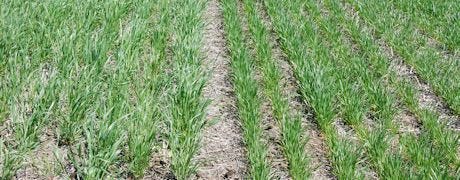
The rules for insuring a cash crop such as corn or soybeans that is planted after a cover crop have changed since last spring. As growers prepare to terminate cover crops before planting corn and soybeans in spring 2014, these new guidelines should be reviewed.
USDA's Natural Resources Conservation Service, or NRCS, USDA's Risk Management Agency, or RMA, and the USDA Farm Service Agency, or FSA, have worked to create guidelines that allow cover crops to achieve their conservation benefits while minimizing risk of reducing yield to maintain crop insurance eligibility.

NEW PROVISIONS: USDA has updated some of the rules for terminating cover crops prior to spring planting of cash crops such as corn and soybeans in 2014.
Cover crop termination guidelines for management zones
USDA's NRCS has released its updated guidelines for terminating cover crops prior to spring planting of corn and soybeans in 2014. Barb Stewart, state agronomist for NRCS in Iowa, says the most important information to gather from the new guidelines is more of a clarification on how farmers can use cover crops. "The new guidelines clearly state that haying, grazing and cutting covers for silage are all acceptable cover crop uses during a typical year," she says. "But farmers must leave enough cover crop biomass to meet the conservation purpose."
According to USDA's Risk Management Agency, crop insurance guidelines, as long as it's not a prevented planting situation or a designated fallow year, then haying, grazing or cutting the cover are all acceptable. Check with your crop insurance agent if you are unsure.
Thinking About A Cover Crop? Start With Developing A Plan
Taking time to design your cover crop plan will increase the successful establishment of the crop and potentially allow for improved staggering of fall harvest.
For farmers who have planted cover crops to benefit their corn and soybeans, you need to use the best timing and considerations for termination of the cover crop, advises Stewart.
NRCS map shows Iowa cover crop termination zones
For 2014 visit directives.sc.egov.usda.gov to view the NRCS guidelines. Additional information on cover crops and crop insurance rules, provided by RMA, can be found online.
The guidelines for cover crop termination zones shown on the NRCS map use four strategic management zones across the U.S., she notes. About a third of Iowa (the western portion) is in Zone 3, while the remainder is in Zone 4.
For farmers in Zone 3, NRCS continues to recommend terminating cover crops at or before planting a corn or soybean crop. Farmers in Zone 4 should terminate cover crops at or within 5 days after planting, but before crop emergence.
Stewart says that if you follow the updated termination guidelines that will provide the best opportunity for farmers to achieve the soil and water conservation benefits from cover crops, while minimizing risk of reducing yield to the following cash crop due to soil water use.
Don't use tillage to kill cover crops
Some cover crops winterkill; others need to be manually terminated through tilling, mowing or applying herbicide. If not terminated properly, cover crops can act as weeds in crop production, slowing soil drying and warming in spring. Stewart recommends avoiding tillage to terminate cover crops. "Tillage negates most of the soil health benefits cover crops provide, and could lead to additional soil erosion issues," she says.
For information about cover crop termination, visit your local NRCS office or go online to the NRCS website and click on "Agronomy" to view the map showing Iowa's termination zones for cover crop termination and other information.
About the Author(s)
You May Also Like




